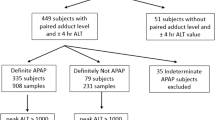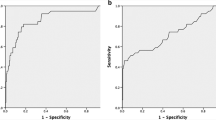Summary
The aim of the study was to compare the feasibility of the MEGX (monoethylglycinexylidide) and antipyrine tests in reference to standard biochemical parameters used for liver assessment in cirrhotic patients. The study was carried out in 44 subjects: 14 healthy controls and 30 cirrhotic patients classified according to the Child-Pugh’s score to subgroups A (n=11), B (n=12) and C (n=7). All subjects underwent two dynamic liver tests, i.e. MEGX (monoethylglycinexylidide) and antipyrine test in a crossover schedule with at least 5-day interval. For the MEGX, lidocaine was administrated intravenously, at a dose of 1 mg/kg, and blood samples for MEGX assay were collected after 15 minutes. MEGX concentrations were measured by fluorescence polarization immunoassay. The antipyrine concentrations were evaluated following a single oral administration of 1000 mg antipyrine. The blood was sampled for 24 hours after the drug administration, and antipyrine concentrations were measured spectrophotometrically. Standard biochemical parameters used for liver assessment were measured by means of routine laboratory methods. It was concluded that in patients liver with cirrhosis, liver dynamic tests were better predictors of hepatic function. The MEGX test was more feasible in clinical setting, but it was noted that antipyrine test was more sensitive in staging liver cirrhosis.
Similar content being viewed by others
References
Oellrich M., Rande E. and Burdelski M. (1987): Monoethylglycinexylidide formation kinetics: a novel approach to assessment of liver function. J. Clin. Chem. Biochem., 25: 845–853.
McPherson G.A., Benjamin I.S., Boobis A.R., Brodie M.J., Hampolen C. and Blumgard L.H. (1982): Antipyrine elimination as a dynamic test of hepatic functional integrity in obstructive jaundice. Gut, 23: 734–738.
Scott N.R. (1988): Caffeine clearance and biotransformation in patients with chronic liver disease. Clin. Sci., 74: 377–382.
Ceasar J., Shaldon S., Chiandussi L., Guevara L. and Sherlock S. (1961): The use of indocyanine green in the measurement of hepatic blood flow and a test of hepatic function. Clin. Sci., 21: 43–57.
Saibara T., Onishi S., Sone J., Yamamoto N., Shimahara Y., Mori K., et al. (1991): Arterial ketone body ratio as a possible indicator for liver transplantation in fulminant hepatic failure. Transplanation, 51: 782–786.
Brodie B.B., Axelrod J., Soberman R and Levy B.R. (1949): The estimation of antipyrine in biological materials. J. Biol. Chem., 179: 25–32.
Oellerich M., Burdelski M., Ringe B., et al. (1989): Lignocaine metabolite formation as a measure of pre-transplant liver function. Lancet, i: 640–642.
Oellerich M., Burdelski M., Lautz H.U., et al. (1991): Predictors of one year pretransplant survival in patients with cirrhosis. Hepatology, 14: 1029–1034.
Arrigoni A., Gindro T., Aimo G., et al. (1994): Monoethylglycinexylidide test: a prognostic indicator of survival in cirrhosis. Hepatology, 20: 383–387.
Shiffman M.L., Luketic V.A., Sanyal A.J., et al. (1994): Hepatic lidocaine metabolism and liver histology in patients with chronic hepatitis and cirrhosis. Hepatology, 19: 933–940.
Reichen J. MEGX test in hepatology: the long-sought ultimate quantitative liver function test? J. Hepatol., 19: 4–7.
Testa R., Caglieris S., Risso D., et al. (1997): Monoethylglycinexylidide formation measurement as a hepatic function test to assess severity of chronic liver disease. Am. J. Gastroenterol., 92: 2268–2273.
Engel G., Hofman U., Heidemann H., Cosme J. and Eichelbaum M. (1996): Antipyrine as a probe for humans oxidative drug metabolism: identification of the cytochrome P450 enzymes catalysing 4-hydroxyantipyrine, 3-hydroxyantipyrine, and norantipyrine formation. Clin. Pharmacol. Ther., 59: 613–623.
Fabris L., Jemmolo R.M., Toffolo G., et al. (1999): The monoethylglycinexylidide test for grading of liver cirrhosis. Aliment. Pharmacol. Ther., 13: 67–75.
Kalow W. (1987): Genetic variation in the human cytochrome P-450 system. Eur. J. Clin. Pharmacol., 31: 633–641.
Howden C.W., Birnie G.G. and Brodie M.J. (1989): Drug metabolism in liver disease. Pharmacol. Ther., 40: 439–474.
Wojcicki J., Drozdzik M., Gawronska-Szklarz Z. and Dadej R. (1994): Lidocaine test patients with compensated liver cirrhosis. Probl. Ter. Monit., 5: 74–78.
Huang Y-S., Lee S-D., Deng J-F., et al. (1993): Measuring lidocaine metabolite monoethylglycinexylidide as a quantitative index of hepatic function with chronic hepatitis and cirrhosis. J. Hepatol., 19: 140–147.
Ercolani G., Grazi G.L., Calliva R., et al. (2000): The lidocaine (MEGX) test as an index of hepatic function: its clinical usefulness in liver surgery. Surgery, 127: 464–471.
Potter J.M., Hickman P.E., Henderson A., Balderson G.A., Lynch S.V. and Strong R.W. (1996): The use of lidocaine-monoethyllglycinexylidide test in the liver transplant recipient. Ther. Drug Monit., 18: 383–387.
Meyer-Wyss B., Renner E., Luo H. and Scholer A. (1993): Assessment of lidocaine metabolite formation in comprison with other quantitative liver function tests. J. Hepatol., 19: 133–139.
Danhof M. and Teunissen M.W. (1984): Antipyrine as a model drug to assess oxydative drug metabolising activity in man. Pharm. Internat. J., 5: 11–23.
Van Moltke L.L., Abernethy D.R., Kaplan M.M. and Greenblatt D.J. (1993): Antipyrine kinetics in patients with primary biliary cirrhosis. J. Clin. Pharmacol., 33: 75–77.
Wensing G., Hoffmann K. and Heidemann HT. Antipyrine elimination in patients with alcoholic and non-alcoholic cirrhosis. Z. Gastroenterol., 31: 15–19.
Grieco A., Castellano R., Matera A., et al. (1998): Antipyrine clearance in chronic and neoplastic liver disease: a study of 518 patients. J. Gastroenterol. Hepatol., 13: 460–466.
Author information
Authors and Affiliations
Rights and permissions
About this article
Cite this article
Wojcicki, J., Kozlowski, K., Drozdzik, M. et al. Comparison of MEGX (monoethylglycinexylidide) and antipyrine tests in patients with liver cirrhosis. Eur. J. Drug Metab. Pharmacokinet. 27, 243–247 (2002). https://doi.org/10.1007/BF03192334
Received:
Issue Date:
DOI: https://doi.org/10.1007/BF03192334




